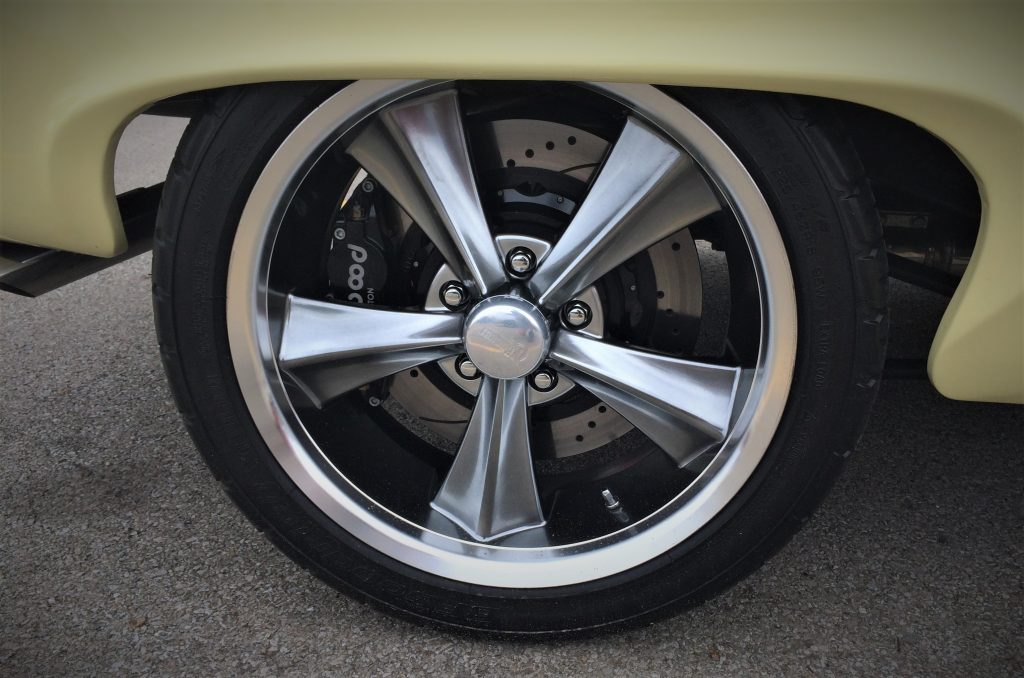
The Henry J was the brainchild of Henry J. Kaiser himself, chairman of the Kaiser-Frazer automobile company. Kaiser felt that, as the U.S. economy recovered from World War II, folks would be looking for budget-friendly transportation.
To keep costs low, the Henry J did away with amenities like a trunk lid, glove box, or roll-down rear windows. Kasier looked to Willys to supply the engines, and you could opt for the same L-134 four used in the Jeep CJ or a more powerful inline six.
Learn more about Frazer here: A Quick History of The Frazer Automobile

Upon its release, the Henry J was priced low.
…Problem was, it wasn’t priced that low.
And folks soon realized that, if they spent just a few hundred more, they could get a much better appointed Chevy or Ford. As a result, the Henry J was a relative flop, and few remain roadworthy today.
That’s why we dang-near fell over when we spotted this one at the recent Goodguys Summit Racing Nationals. And when we saw its license plate, we absolutely had to talk to its owner to learn more.

“My wife wanted one for a long time. And we were both born in 1951,” owner Wally Melvin explains. “So I found this one—and I knew what I was going to do with it the minute I saw it,” he grins.
But there was one big catch:
“I wanted it to still look like a Henry J,” he reveals.
That meant no altered wheelbase, fender flares, modern interior, or massive hood bulge. With that guideline established, Melvin gave us the details of the build.
For starters, the project took about a two and a half years. The engine was poached from a 2015 Ram 2WD truck. It’s a 5.7L Hemi that’s wearing a later 6.1L-style manifold, and Melvin retained the truck’s eight-speed automatic.
Want to learn more about the Chrysler Gen. III Hemi? Read our Hemi Spec Guides.
“The truck’s rear end was way too big,” Melvin explains, so he opted for a modified Ford nine-inch. “But it’s got the driveshaft from the truck,” which he had to cut down significantly to fit it under the diminutive Henry J body.
The chassis has been boxed and the Henry J is fitted with a Ridetech coil over suspension.

When asked about the project’s overall difficulty, Melvin is laughably humble. “After we got it all figured out. It wasn’t that bad,” he jokes. But then he admits that going the Mopar route had some challenges. “Everyone’s done the LS, but [the Hemi] was kind of a learning process.”
Melvin describes how he had to get a computer-controlled engine and transmission to play nice with things like a modified driveshaft and relocated speed sensors. “We changed the shifter three times,” he continues. “And even changed the gas pedal a few times to get it to fire up.”

And we really wanted to hear about how a 1950s compact economy car does with modern V8 power.
“It drives straight down the road, honest to God,” Melvin laughs as he mimics two fingers placed on the steering wheel.
Turning our attention inside, Melvin made some concessions on his stock-appearance rule. “I had to run a Dakota Digital speedometer, because everything’s electronic now,” he admits. But most everything else is original, including the seats, dash, and steering wheel.

….Well, maybe not that small toggle switch behind the custom shifter console. That activates the exhaust cutouts—because: AWESOME. (Image/OnAllCylinders)
Thinking about undertaking a big project like this? Perhaps something really outside of the box and concerned you’ll get stuck on a particular aspect of the build?
Melvin offers some reassurance:
“That’s the thing, there are people out there, and somebody, somewhere knows how to do it,” he explains.
“There’s somebody out there that has done something like it. And 98 percent of those people will help you—they will bend over backwards to help you out.”
And judging from the smiles and handshakes he received from other fascinated gearheads as we talked with him, we’re sure that Melvin is part of that 98 percent.
***






my friend had a chevy J (L88 /427) back in 1968 OR 1969 when i was a young man .
Building 51 henry j. 327. An powerglide. What trans moount fts well.